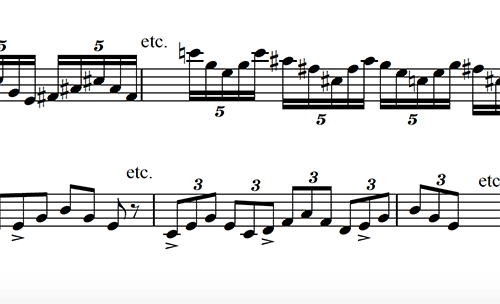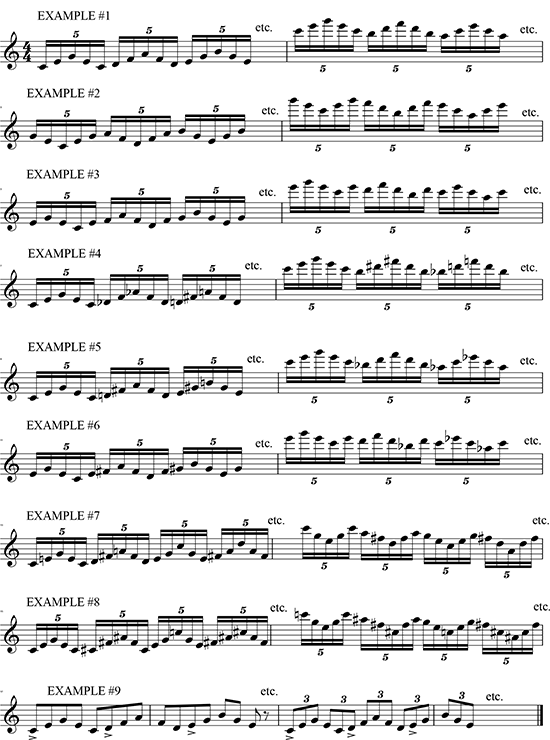Using Quintuplets to Generate Endless Improvisational Ideas
 If you’re like me, you’re always looking for ways to vary your practice routine, improve sense of rhythm and expand your language as an improviser.
If you’re like me, you’re always looking for ways to vary your practice routine, improve sense of rhythm and expand your language as an improviser.
Here are a few exercises that incorporate groups of five notes (quintuplets) into some very simple triadic exercises that you can practice over the entire range of the saxophone.
Some of you might find quintuplets a bit daunting, but they’re nothing to be afraid of. Find any five syllable word or phrase and then tap quarter notes with your foot or put your metronome on at a nice medium tempo. Say your word of phrase – I like using the word “hippopotamus”. “Tenor saxophone” also works well, or “alto saxophone” for those of you with a bit of a bias towards the smaller horn – and just say that word or phrase in time with your foot or the metronome.
Not too bad, right? Being able to feel these fives will do wonders for your sense of time, and quintuplets aside, you can also group eighth notes and triplets into groups of five, which will start to get you to feel accents in perhaps some new places. Now for the examples. (Note: These are all written in C Major. As always, take these examples through all your keys).
- In Example 1, we take just the basic triads built off the major scale and work our way up and then back down.
- Example 2 takes this same idea and just flips it around.
- Example 3 is much the same idea, but starts on the third degree rather than the root.
- Example 4 takes the basic triads and works it’s way up chromatically.
- Example 5 moves triads by whole step.Example 6 does this same thing, but starts on the third degree of each triad.
- Example 7 starts to work with triad pairs, which is where the real fun can begin for many of you. A triad pair is any pair of triads that don’t have any common notes. Note: For more on triad pairs, see Walt Weiskopf’s excellent book Intervallic Improvisation – The Modern Sound: A Step Beyond Linear Improvisation. Let’s start off with two Major triads that are a whole step apart and work them into our basic pattern from Example 1.
- Example 8 uses a more exotic triad pair, which are two triads a tritone apart (C + F#)

Once you start to work with these triad pairs, the possibilities are endless, as you can then use all the variations from the earlier examples to build your own patterns. And don’t forget your minor keys as well!
And as I mentioned before, you can do five note groupings with eighth notes and triplets as well (see example 9).
As always, practice slowly, mindfully, and creatively. Besides going through these to build your technique and vary your general routine, think about how you can incorporate these into your improvisation as well.
CLICK HERE TO DOWNLOAD PRINT-FRIENDLY PDF OF EXERCISES.
I’d love to see your own ideas and variations in the comment section below.
Learn with and Listen to Sam
Sam Sadigursky is currently offering online lessons through Skype and private lessons in NYC. He has given improvisation clinics across the U.S., is a regular guest professor at Hunter College, and currently performs internationally with Darcy James Argue’s Secret Society, Folklore Urbano, and others. His new book, 12 INTERVALLIC ETUDES for Saxophone, is available here. His albums can be purchased at http://samsadigursky.bandcamp.com. To find out more, visit SamSadigursky.com.






January 3, 2018 @ 11:04 am
HEY..you guys work FAST! thanks a TON AND 3/4 !!!! pc
January 3, 2018 @ 11:43 am
A sequence in music is repeating a motif up to 3x’s with each motif up or down a similar interval. arpggios, small parts of different modal scales can be included. Playing only pre-planed sequences of intervals is not music & is boring!